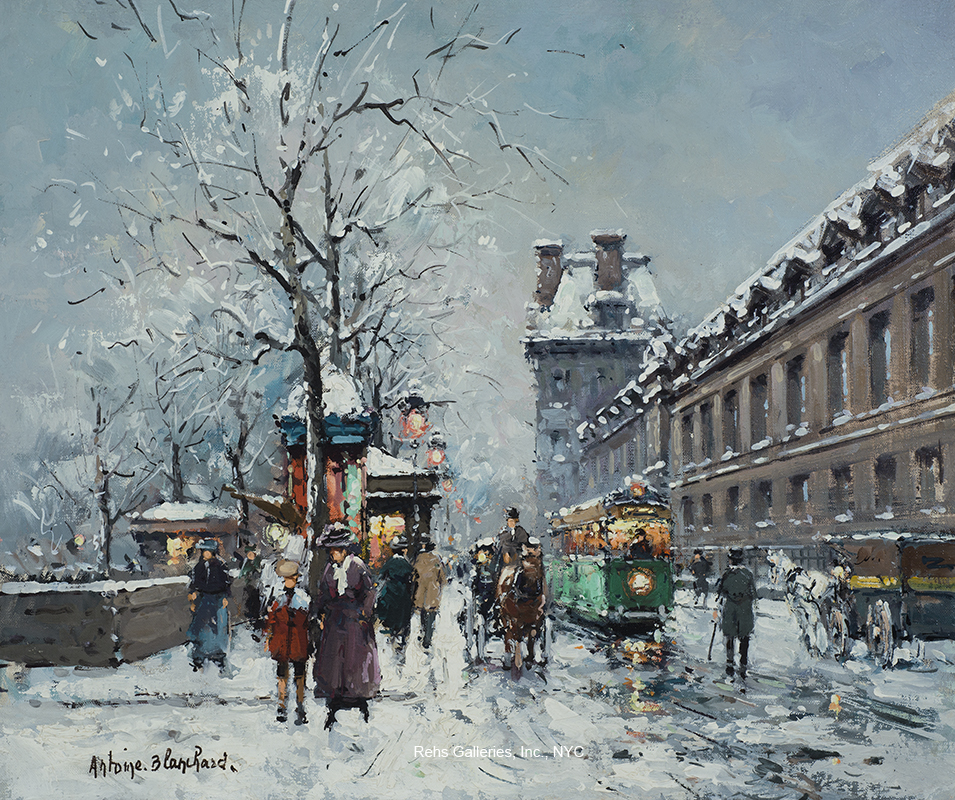Source: Quai du Louvre, Hiver – more snow in the forecast … so here is a classic Paris snow scene by Antoine Blanchard that we just added to our available online inventory.
Source: The Sites of Paris: Yesterday and Today, by Amy Rehs – Quai du Louvre is the riverbank on the Seine by the Louvre Museum.
The Louvre Museum (Musée du Louvre), located on the Right Bank of the Seine, between the Tuileries Gardens and the church of Saint-Germain l’Auxerrois, is among the most visited, oldest, largest and famous museums in the world. The building, originally a royal palace, is famous for displaying many of the world’s most important works of art; including Leonardo da Vinci’s Mona Lisa, The Virgin and Child with St. Anne, Madonna of the Rocks, and Alexandros of Antioch’s Venus de Milo.
According to the French historian Henri Sauval (1623-1676) the word ‘Louvre’ is from the Frankish word leovar or leower, signifying a fortified place. The Louvre became the royal residence and the official seat of power in France until Louis XIV moved to Versailles in 1682, bringing the government with him.
The construction of the Louvre began in the thirteenth century when Phillip II Augustus built a fortress to defend the Seine and l’île de la Cité against the Normans and the English. Then, in the fourteenth century, Charles V remodeled and enlarged the building. In the sixteenth century, François I and Henri II demolished most of the structure to build a Renaissance Palace, designed by Pierre Lescot and decorated with sculptures by Jean Goujon. The original foundation of the fortress tower is under the ‘Room of the Carytids.’
In 1564 Catherine de Médici built Palais de Tuileries, just to the west of the Louvre. Subsequently, Henri IV decided to have the two connected with a series of buildings, the most important being the Grande Galerie. The building was 100 feet wide and more than a quarter mile long, making it the longest building in the world at that time. Henri IV, a great patron and supporter of the arts, invited hundreds of artists and craftsmen to live and work in this building’s lower floors, a tradition that lasted for two hundred years until Napoléon III ended it.
The Denon Wing, as it known today, was started by Catherine de Médici in 1560 and completed by Louis XIII in the seventeenth century. He also extended the west wing by adding the pavilion de l’Horoge, a doomed clock pavilion. When Louis XIV came into power, he had a great square constructed, the Cour Carée by Louis Le Vau. He then commissioned Le Vau and Claude Perrault to design the East Wing; its classical edifice has been the model for many great European and American buildings, one being the Metropolitan Museum of Art in New York. (In 1682, Louis XIV moved the royal residence to Versailles.)
Following the Revolution of 1789, Napoléon I moved the royal residence back to the Palais de Tuileries and used the Louvre for both government offices and the first state museum, which housed the royal collections of painting and sculptures. Napoléon I began a new west wing along the rue de Rivoli and Napoléon III completed it; thus closing the quadrilateral.
Today, the Louvre departments include Oriental (ancient Mesopotamian) antiquities, Egyptian antiquities, Greek and Roman antiquities, sculpture from the Middle Ages to modern times, furniture and object d’art, and paintings representing all of the European schools.

